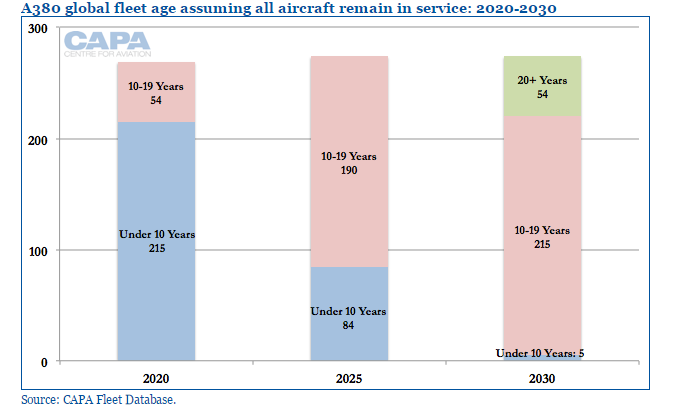Iranian aviation is being revitalized with the long-term prospects of reestablishing a global hub in Tehran.
The first of many steps is re-fleeting and growth at the national airline Iran Air, which has confirmed orders for 180 aircraft from Airbus and Boeing. The 80-aircraft Boeing order includes 737 MAXs, 777-300ERs and 777-9s, while the 100-aircraft Airbus order includes A320s, A321s, A330s and A350s.
Iran Air has dropped preliminary plans to take 12 A380s. Although this is being marked as the latest blow to the A380 order, the acceptance of A380s was always a distant prospect.
Tehran is a small hub prospect in the short term and, irrespective of whether Iran Air could find sustainable markets for the type, by the time Iran Air planned to receive its first A380 the type would be well into its mid-life, with dwindling spare parts and support, reads an article published on the website of CAPA-Center of Aviation. Excerpts follow:
A380 phase-out is beginning. Of the A380s early operators: Singapore Airlines is not renewing the leases on its initial A380s, Emirates will have new A380s replace older A380s it expects to part-out, and Qantas is studying stretched A350 types and the 777X to replace its A380s.
That said, there may be renaissance concepts for the aircraft, such as Malaysia Airlines’ charter plans.
Airbus, Boeing Deals Finalized, Sans A380
For Airbus, Iran Air has finalized an agreement for 100 aircraft, which is broadly split between narrowbodies (A320 and A321) and widebodies (A330 and A350). The A380 is no longer included.
The industry was excited to see a new-build A321 in Iran Air colors at an Airbus plant awaiting delivery, likely in Jan. 2017.
Iran Air’s first new-build Boeing delivery is expected in 2018. Iran Air has agreed to 80 aircraft, comprising 50 737 MAX 8s, 15 777-300ERs and 15 777-9s.
At least two undisclosed leasing companies will finance 77 aircraft, including 42 from Airbus and 35 from Boeing, Reuters reported.
Uncertain Spare Parts and Support
Putting aside whether or not Iran Air would have sustainable markets for the A380, there is the matter of the aircraft’s age.
Iran Air’s A380s were tentatively scheduled for delivery from 2020 to 2022. The A380 was designed in the late 1990s/early 2000s, meaning Iran Air would take delivery of an aircraft with a 20-year-old design lacking any significant upgrade.
As of Dec. 2016, 74% of all A380s expected (in CAPA’s Fleet Database) to be built in the program’s lifetime have already been delivered. In 2017, the assembly will be completed of 85% of all projected A380s; a revival on any scale looks unlikely.
Assuming a first delivery in 2020, Iran Air would receive its first A380 when 20% of the global A380 fleet would be over 10 years old and facing retirement in the coming years. This includes aircraft, such as at Singapore Airlines and Emirates, that will likely be retired before 2020 and either broken up or possibly re-leased, but the figures are oversimplified for clarity.
Again assuming a 2020 delivery, within a few years of operating, the A380 Iran Air would have seen a marked change in the type’s age distribution: in 2025, 69% of A380s would be 10-20 years old and facing retirement.
By the time Iran Air’s A380s would have around a normal half-life, in 2030 there would be only a handful of other A380s under 10 years old.
Besides the direct financial concern of operating an old-design aircraft, support and spare parts would gradually become an issue for what is already a relatively low volume production aircraft, although obviously Airbus would take steps to ensure supply.
There could be further challenges since most of the support and spare part industry will be focused around Emirates, which for competitive reasons may not regard it as being in its interest to help Iran Air attain good commercial deals for A380 support.
The A380’s initial three operators, namely Singapore Airlines, Emirates and Qantas, are preparing to phase out some or all of their A380s.
Iran Air Was Never A380’s Savior
2016 starts and ends with no Iran Air A380. The A380 was included in Iran Air’s initial agreement in early 2016.
However, as the buzz and excitement of Iranian aviation growth normalizes and the focus turns to details, financials and ultimately profitability, it is not surprising to see the A380 order not being finalized.
At the very least, both Airbus and Iran Air probably received more attention from the possibility of the A380 than they would have otherwise. The door will of course remain open for an order, but from Iran Air’s planning perspective, prudency dictates watching how the market evolves, as long haul smaller widebody routes attract much attention.
For Airbus, this is not a major setback. Besides Iran Air being a late prospective A380 order, it was always uncertain. With an order of only 12, the deal was not going to be the savior for the A380 program in any case. And with no other major deals or immediate prospects, there was not a chance of an Iran Air A380 order contributing to a new lease of life for the A380.
The A380 program finds itself back where it was, while Iran Air is marching towards revitalization. All in all, a practical outcome.


